Diwali Around India
Celebrated with great excitement and grandeur, Diwali or Deepavali is
one of the prime Hindu festivals that unites the whole of India. Know
about the different ways in which this sparkling festival is
celebrated in different parts of the country.
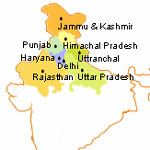
North India :
According to the great Hindu epic ‘Ramayana’, Diwali is
believed to be the time when Lord Rama defeated and killed the evil
King Ravana and after passing a period of of fourteen years in exile
returned to his capital Ayodhya (in the Faizabad district of Uttar
Pradesh) on a new moon day of the Kartik season with wife Sita and
brother Lakshman. This homecoming of Lord Rama was celebrated with
lights, fireworks, bursting of crackers and merriment. The tradition
continues to this day in the northern states of Uttar Pradesh, Punjab,
Haryana, Bihar and the surrounding areas where huge effigies of Ravana
are burned symbolizing Lord Rama's vanquishing of the demon king. The
Diwali night, in these areas, is a night of fireworks with sparklers
and crackers of all types burnt throughout the night. The idols of
Goddess Lakshmi, the symbol of wealth and prosperity and Lord Ganesha,
the elephant-headed god, the symbol of auspiciousness and wisdom, are
worshipped in most Hindu homes on this day. Most of the temples
dedicated to the worship of Lord Rama or Krishna celebrate Diwali with
great piety and eagerness.
Eastern India :
In the eastern region of the country, Diwali is
celebrated with great fanfare. In Orissa, oil lamps, candles and
lanterns are lit and placed in rows around individual homes. Crackers
are burst, sparklers lighted and gifts and sweetmeats distributed by
people across the state.
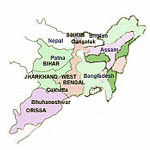
The celebration here is almost like anywhere
in India save for one ritual that calls upon the spirits of the
family's forefathers. A primitive custom in this festival includes
burning of jute stems to light up the dark path that the spirits of
the ancestors supposedly take to go back to heaven. Most of the houses
are brightly lit and the doors and windows kept open to welcome
Goddess Lakshmi, who is supposed to visit every home during this time
and ignores all places that are kept dark and abandoned.
In West Bengal, Lakshmi puja is celebrated earlier than the Diwali
celebrations and the deity celebrated on this occasion is the fierce
Goddess Kali. "Kali Puja" or the worship of Goddess Kali is what makes
the celebration in this part of India a unique one. In Kolkata, the
capital of the state, as well as in all the other parts of West
Bengal, the nights of "Kali Puja" are marked by high festivities that
consists of activities similar to other regions like bursting
crackers, holding dazzling fireworks display, lighting rows of candles
and diyas around individual homes, painting colorful patterns at the
doorstep, dressing up in new apparels and paying a visit to friends
and relatives. Across the state, makeshift structures called pandals,
made of articles as bamboos and cloth, are erected that house idols of
Goddess Kali for the two days of celebration. The actual worship of
the deity is, however, done only for one night during this festival.
It is also believed that it is the night of the 'Pitripurush'
(ancestors) and lamps are lit on long poles to guide their souls on
this night. But the practice is more common in rural areas of Bengal
than in cities like Kolkata.
Western India :
In the western states of India, Diwali is a four-day
festival, the preparations for which begin at least 15 days in
advance.
The markets liven up almost a whole month in advance for
Diwali shoppers and the shopping frenzy peaks with the advancement of
the occasion. On the night preceding Diwali, Gujaratis start
celebrations by creating designs depicting images associated to the
festival like deities, sun and flowers from natural powder
colors (called "Rangoli") in their verandas. Images of small footprints
are also drawn over individual doorsteps which is supposed to be a way
of inviting Goddess Lakshmi to the house.
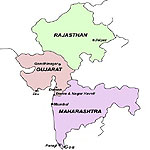
On the first day, Narakchaturdashi, fruits are smashed and crackers
burst to symbolize the killing of the evil demon Narakasur. On Lakshmi
Pujan, the second and most important day of Diwali, Hindu homes all
over the western region of India worship the idols of Lord
Ganesh (deity of auspiciousness and wisdom) and Goddess Lakshmi (deity
of wealth and prosperity) or symbols of them like currency notes and
gold. The third day, Padawa, is considered to be one of the most
auspicious days of the year in states like Maharashtra, and is held to
be propitious for beginning any important task. This is the day for
shopping, lighting diyas (earthen lamps) and performing tilak ceremony.
In Gujarat, this is the New Year day when people visit each other to
wish a new beginning. Bhau Beej is the last day of the festival that
signifies sibling bonding and the celebrations during this day is
quite akin to Rakhi, another great Indian festival standing for the
brother-sister relationship. Unlike Raksha Bandhan however, which is a
day dedicated to brothers, Bhau Beej is dedicated to sisters.
Southern India :
In Southern India, Diwali is is celebrated in the
Tamil month of aipasi (thula month) 'naraka chaturdasi' thithi,
preceding amavasai. Naraka chaturdashi is the main day of the Diwali
celebrations in this area. The preparations begin the day before, when
the oven is cleaned, smeared with lime, religious symbols drawn on it
and then filled with water for the next day's oil bath. Individual
homes are washed and decorated with kolam designs (akin to rangoli
patterns in North India). Firecrackers and new apparels are kept on a
plate to be used on the following day. On the morning of Naraka
chaturdashi, the actual celebrations begin with an early morning oil
bathe before sunrise. Afterwards, sweets are eaten and new clothes
worn.
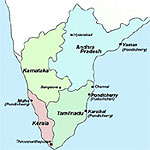
A unique Diwali custom in Tamil Nadu is the once-in-a-lifetime event,
Thalai Deepavali, when newly weds spend their first diwali after
marriage in the bride's parental home. The newly married couple, after
taking blessings from the elders, burst the first crackers of the day
and thereafter pay a visit to the temple, get gifts of clothes and
jewellery, savor the sweets reserved for them and receive blessings of
elders for a happy married life. In this joyful occasion the groom's
parents and relatives also come down to join in the celebrations.
In Maharashtra, Diwali is celebrated over a span of four days. The
first day, Vasubaras, is celebrated by performing an Aarti (prayer with
songs) of the cow and its calf- which represents the love between a
mother and her baby. The next day is Dhanatrayodashi or Dhanteras, a
special day for tradesmen and business people for new account books
are opened by them after a worship of Lord Ganesh and Goddess Lakshmi.
On the third day, Narakchaturdashi, people get up before sunrise and
take a bathe after rubbing scented oil on their body. After this, the
entire family visits a temple and offers prayers to their God.
Following this, everyone feasts on Faral, a special Diwali preparation
consisting of delicious sweets such as "karanji" and "ladoo" as well
as some spicy eatables like "chakli" and "sev". The fourth day is
Lakshmi pujan day, a new moon day, the dark night of which is
illuminated by lamps and fireworks. In every household, an idol of
Goddess Lakshmi and items of wealth like currency and jewellery are
worshipped. Friends, neighbours and relatives are invited over and
celebrations are in full swing.
Rural India :
In the rural regions of India, the Diwali celebrations, apart from its
other significances, also stand in for harvest celebrations. In
villages across the country, Diwali is the time that farmers celebrate
with joy and offer praises to God for granting them a good crop. In
the morning, variously colored Rangoli or Kolam designs denoting
shapes as the footsteps of Goddess Lakshmi are drawn at individual
doorsteps and also all over the houses to usher in wealth, fortune and
prosperity. Idols of Goddess Lakshmi and Lord Ganesha are worshipped in
most Hindu homes on this day. At dusk, the real jubilations begin.
Tiny earthen lamps and candles are arranged all over individual huts
in rows and create a beautiful sight to behold. People wear new
apparels, burst firecrackers and light sparklers, visit the places of
their relatives and friends to wish them on the occasion of Diwali and
exchange gifts. All this illumination and fireworks, joy and
festivity, symbolize the triumph of divine forces over those of
wickedness, or rather - of good over evil.





 Friendship Day
Friendship Day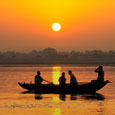 Good Morning
Good Morning